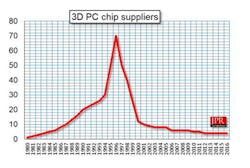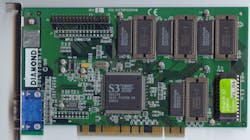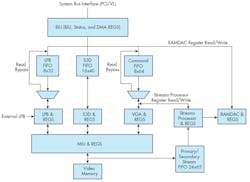S3 ViRGE: Trying For Virtual Reality Too Early
>> Electronic Design Resources
.. >> Library: Article Series
.. .. >> Series: The Graphics Chip Chronicles
.. .. .. >> Introduction to this Series
.. .. .. << Multi GPUs: A Story of Promise and Potential Failure
In the mid-1990s, two major developments in the graphics industry were taking place. One was the explosion of 3D graphics chip companies, and the other was an attempt to bring virtual reality from the lab to consumers.
In 1990, twenty companies were making or had declared they would make a 3D graphics chip. By 1996, the number of suppliers exploded to 70. But in 2000, the number of suppliers had dropped to 12. No one had anticipated the complexity of developing such a chip. And the dot-com bubble bursting leveled many of the companies.
Around 1990, the concept of virtual reality began to become popular. Before then, the virtual reality industry mainly provided devices for medical, flight simulation, automobile industry design, and military training purposes. By the end of the century things had gotten quiet as the dream of VR failed to live up to its promises.
In 1989, S3 was founded and began development of a 2D graphics controller. In 1991, the company introduced it S3 911 graphics chip as a Windows (or GUI) accelerator. The company did very well and introduced a series of follow-up 2D controllers.
When the Sony PlayStation, and then the Nintendo 64, were introduced in the mid-1990s with 3D capabilities, consumers and OEMs began to demand 3D functionality from PC graphics cards. S3 responded to the demand and, in 1995, introduced the S3 Virtual Reality Graphics Engine (ViRGE) graphics chipset. It was one of the first 2D/3D accelerators designed for the mass market. S3 sought to capture two hot market opportunities at once—VR and 3D.
The ViRGE, also called the 86C385, was actually a relatively run-of-the-mill 3D controller, but was successful on the market because of its low price and excellent 2D capabilities, which at the time was still the major market in video games.
The S3d Engine provided 2D acceleration for Windows applications performance and a high-performance 3D rendering engine for games and other interactive 3D applications.
It incorporated key Windows accelerator functions of BitBLT, line draw, and polygon fill. 3D features included flat shading, Gouraud shading, and texture mapping support. Advanced texture mapping features spanned from perspective correction, bi-linear and tri-linear filtering, to MIP-Mapping, and Z-buffering. The S3d Engine also had direct support for utilizing video as a texture map. Those features provided the most realistic user experience for interactive 3D applications at the time.
Other advanced features of the S3d Engine included S3’s proprietary compressed texture formats, which the company said resulted in improved performance and reduced memory requirements. The engine also provided support for S3’s MUX buffering feature, which allowed for Z-buffering support with no additional memory cost.
S3 was also one of the first companies to offer a Streams Processor. The streams processor provided the stretching and YUV color space conversion features required for full-screen video playback with both software codecs and hardware MPEG-1 sources.
The streams processor opened the door for the simultaneous display of graphics and video of different color depths. For example, it was possible to display 24 bpp-equivalent video on top of an 8-bit graphics background. That saved memory bandwidth and storage capacity while permitting higher frame rates.
The chip also offered what S3 called its Scenic Highway. This technology created a low-cost direct connection to S3’s Scenic/MX2 MPEG-1 audio and video decoder as well as video digitizers such as Philips’ SAA7110/SAA7111.
The full list of features:
High-Performance Integrated DRAM-based 2D/3D Graphics and Video Accelerator
- High-performance 64-bit 2D/3D graphics engine
- Integrated 135 MHz RAMDAC and clock synthesizer
- S3 Streams Processor for accelerated video
- S3 Scenic Highway for direct interface to live video and MPEG-1 peripherals
- Pin compatible with S3 Trio64V+
S3d Graphics Engine Features
- High performance 2D Windows acceleration
- Flat and Gouraud shading for 3D
- High quality/performance 3D texture mapping
- Perspective correction
- Bi-linear and tri-linear texture filtering
- MIP-Mapping
- Depth cueing and fogging
- Alpha blending
- Video texture mapping
- Z-buffering
S3 Streams Processor Features
- Supports on-the-fly stretching and blending of primary RGB stream and RGB or YUV (video) secondary stream
- Each stream can have a different color depth
- High-quality hardware-assisted video playback with horizontal interpolation Support for Indeo, Cinepak, and software and hardware-accelerated MPEG-1 video
S3 Scenic Highway Interface
- Philips SAA7110/SAA7111 video digitizers
- S3 Scenic/MX2 MPEG-1 audio/video decoder
High Screen Resolution (Non-interlaced) Support
- 1280x1024x256 colors at 75 Hz refresh
- 1024x768x64K colors at 85 Hz refresh
- 800x600x16.7M colors at 85 Hz refresh
High-Performance Memory Support
- 64-bit DRAM memory interface
- 2 MB and 4 MB DRAM video memory
- Single-cycle EDO operation
Non-x86 CPU Support
- Big endian/little endian byte ordering
- Relocatable addressing
Industry-Standard Local Bus Support
- Glueless PCIe Gen 2.1 bus interface
- Glueless VESA VL-Bus interface
PCI Bus Mastering for Display List Processing and Video Capture Support
Multimedia Support Hooks
- S3 Scenic Highway
- VESA advanced feature connector
- 8- and 16-bit bi-directional feature connector
Full Software Support
- Drivers for major operating systems and APIs, including Windows 95, Windows 3.11, Windows NT, OS/2 2.1 and 3.0, ADI 4.2, Direct 3D, BRender, RenderWare, and OpenGL
Green PC/Monitor Plug and Play Support
- Full hardware and BIOS support for VESA Display Power Management Signaling (DPMS) monitor power savings modes
- DDC monitor communications
Extensive Static/Dynamic Power Management
Industry-Standard 208-pin PQFP package
The S3 ViRGE provided linear addressing of up to 4 MB of display memory. Linear addressing of more than 64 KB required that the CPU be operated in protected mode. Linear addressing is useful when software requires direct access to display memory. ViRGE offered two linear addressing schemes. The first method could be used when memory-mapped I/O (MMIO) is disabled or with the existing MMIO method. The second was used in conjunction with the new MMIO method. The newer method for ViRGE offered a 64 MB addressing window.
S3 went public in 1993, but the industry was shifting, and S3 struggled to maintain growth by building additional chips, such as an audio processing chip. By 1999, the company found itself in financial trouble, in part due to the collapse of the dot-com bubble and the emergence of Nvidia and ATI. The number of 3D chip companies was dropping rapidly.
Looking for other markets and financial support, S3 formed a partnership with Taiwan-based VIA Technologies. S3 would incorporate its 3D chip technology in an integrated graphics chip (IGC) made by VIA. The IGC was produced in a 180-nanometer process and would work with AMD and Intel x86 processors, providing North-bridge functions. (Ironically, in 1989, the original business plan of S3 was to build core logic parts. That was partly due to the founders’ experience from their C&T days). A 10-year IP swap in 1998 gave S3 access to Intel’s buses and processor I/O.
At the time, S3 held a 16% ownership stake in UMC, a semiconductor foundry. UMC was manufacturing the IGC, giving S3 and VIA a pricing advantage.
Still trying to find a path forward, S3 bought one of its OEM add-in board customers, Diamond Multimedia, in late 1999. That just about ended all the company’s other AIB partnerships, damaging its cash flow and leading to other losses with PC OEMs.
A month later and running low on cash, S3 announced the formation of S3-VIA, a joint partnership. At the same time, the company was developing a music player it would show at the Comdex conference.
Trying to buy more business in early 2000, S3 considered purchasing what was left of Number Nine in the hopes that it would gain its supply deal with IBM. At the last second, S3 pulled out of the talks, and Number Nine filed for bankruptcy. Rumors circulated that cash-strapped S3 would be acquired by VIA. Months later, VIA acquired S3 for $320 million in a convoluted deal. In 2003, the company filed for bankruptcy.
Epilogue
In July 2011, HTC Corporation announced that it would buy the VIA Technologies stake in S3 Graphics, becoming the majority shareholder of S3 Graphics. That signified the last chapter in the company’s history. Even though the S3 ViRGE never used in any VR devices, HTC has transformed into one of the leading VR headset vendors.
>> Electronic Design Resources
.. >> Library: Article Series
.. .. >> Series: The Graphics Chip Chronicles
.. .. .. >> Introduction to this Series
.. .. .. << Multi GPUs: A Story of Promise and Potential Failure




